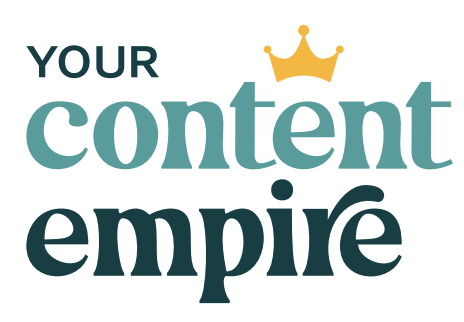There comes a time in your content creation journey where you start to question whether you’ve already said everything there is to really say about your topics. Basically, do you have enough content?
One of the ways you’ll know you’re getting close is when you start really struggling to come up with content topics you’re excited to cover for your editorial calendar.
I talk about this a bit in this post about expertise mapping and the main idea is that instead of thinking about your content as one-off pieces, it’s important to consider your content as an overall body of work.
What are your key messages? What are your signature processes? What does a full and complete body of work look like for you?
This way, you can identify what pieces you might be missing and know when enough is enough and shift your attention to content distribution and other marketing strategies.
In addition to this mindset shift, I also have 5 questions I use when helping clients decide whether they’ve created enough and are ready to adopt the minimalist content strategy.
Here are those questions:
Question #1: Do I have enough content for my paid offers?
The first question around whether you have enough is actually a bit of a reframe. It’s normal to ask if you have enough content, but it’s smarter to ask whether you have enough content for your paid offers.
I’ve been creating a lot of content for a lot of years. But is that content all still relevant to what my business offers? Nope.
When you’ve been in business in 3+ years, your offers have likely changed quite a bit from when you began to now. And with your offers, your content focus has likely changed quite a bit too.
The other thing I love about this question is that it naturally puts your paid offers at the center of your content strategy.
Since you’re a business owner (or working in a business) who creates content FOR BUSINESS, your free content should all lead (either directly or, more likely, indirectly) to your paid offers.
You should be able to make a logical leap and assume that anyone who consumes and engages with your free content is a potential lead for your paid offers. If not, there’s probably a misalignment somewhere in your strategy.
Ask yourself: Do you have enough for your paid offers?
Question #2: What is the quality of my content?
Another question to ask if you’ve been creating content for what might feel like forever is around the quality of that content.
There are some pieces that I created early on that are CRINGEY. I’ve mostly unpublished and forwarded those ones now or updated them.
This is going to require a little honest introspection and the answer is best found when ego can be put aside—because you may not love the answer.
One of the things I find helpful to consider is how you’d feel if a potential customer were to stumble on that piece today. Gut says “good to go”? Great—keep it!
Ask yourself (overall and for each individual piece of content): What is the quality of your content?
Question #3: What content am I missing?
Along with thinking of your content as a body of work over individual pieces is to think about what pieces you might be missing from your customer’s journey from “free content consumer” to “paying customer.”
Are there any objections you need to tackle? Questions that need to be answered? Examples that need to be shown? Goals and benefits that need to be explored? Prerequisite problems that need to be solved?
While you don’t need to answer every little thing in your free content, making sure you’ve covered the big stuff is important and it might be the case that you need to create a few more pieces before you consider yourself DONE with creating new content.
Ask yourself: What content are you missing?
Question #4: Do I have enough sales content for my main paid offers?
Our next line of inquiry revolves around your paid offers—because we’re thinking beyond just your core blog posts (or podcasts or videos if those content types are your jam).
For each of your main offers that you plan on selling—do you have all the sales content you need? Review your salespage, sales emails, promotional posts, promotional images for the offers.
As a rule of thumb in deciding whether I have enough, I like to make sure I have around 21 sales emails with social media post versions of them, images for each of those social media posts.
I created a post here about how to create an evergreen promotional packet for your paid offers that might be helpful if you’ve identified you have a gap here.
Ask yourself: Do you have enough sales content for your paid offers?
Question 5: What's your desired publishing frequency?
The final question that’ll help you really get clear on whether you have enough content (for now or forever) has to do with how you define “enough.”
Most of the people I go through this questioning process with are doing it so that they can decide if they’re ready to implement the Minimalist Content System. And if that’s the case, this last question is essential because we need to figure out how much content you need to cover you for the desired amount of time you want to “put it on autopilot.”
And the answer might vary from person to person, from goal to goal.
Here are a couple of examples:
- Example #1: I want to take 3 months off content while I work on a new course. I plan on publishing weekly so I need around 12 weeks of content. I know that every 4 weeks, I want to have a 2 week sales campaign using sales emails I already have for my main offer. So in this case, I’d need 2 campaigns. Each campaign will run for 6 weeks (4 weeks of blog post emails and 2 weeks of sales emails). I need 8 blog posts total for both campaigns and sales emails for 2 x 2-week flash sales.
- Example #2: I want to stop creating new content and just leverage the assets I already have. I plan on publishing weekly so I need around 52 weeks of content. I know that every 4 weeks, I want to have a 1 week flash sale campaign. I also know I want to alternate selling 2 different offers. Each campaign lasts 5 weeks (4 weeks of nurturing blog post emails and then 1 week of sales emails). I also can share each post up to 2 times per year (as long as there’s at least 6 months between when I’ve shared it last). So I’m planning to create a capsule content collection of 12 posts for each offer and then enough sales emails for 3 flash sales for each offer too.
So the answer and the math of how many posts you need will ultimately depend on how you plan on using them.
Ask yourself: How many posts do you need based on your publishing frequency?
Want (free) support on planning out your Minimalist Content Strategy?
This free on-demand workshop will help. Sign up here ↓














